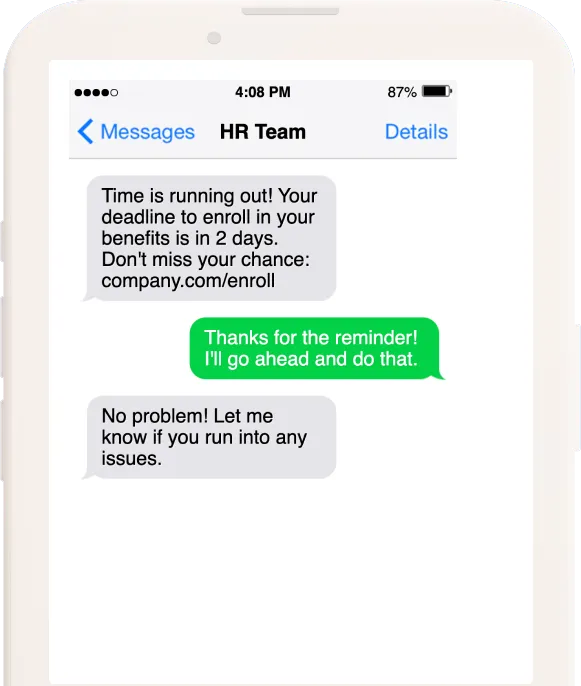Employee engagement is no longer a nice-to-have—it’s essential for organizational performance. Yet even well-intentioned HR teams often fail to reach employees in ways that inspire action. Fortunately, communication tools like SMS and email are now playing a vital role in this equation. When implemented strategically, these platforms can create an inclusive and responsive culture that supports both employee experience and company success.
Understanding the Role of HR Communication
Multichannel communication ensures employees receive timely updates regardless of role, location, or schedule. In today’s fast-paced hybrid work environment, this is more crucial than ever.
- Email is effective for structured updates, policy rollouts, and informational content.
- SMS excels at immediacy, urgency, and driving action through quick reminders.
When used in tandem, these tools provide balance—email handles the depth, and SMS ensures attention.
Psychological Drivers of Employee Engagement
Employee engagement is shaped by emotional connections and perceived value. Timely communication influences both.
- Immediacy from SMS addresses psychological needs for clarity and guidance.
- Depth and detail from email reinforce confidence in decision-making.
- Personalized messaging improves connection, especially when messages are segmented based on role, location, or tenure.
Behavorial psychology supports the use of micro-messages (SMS) to prompt small actions, while rich media (email) helps reinforce learning and clarity.
Strategic Benefits of SMS for HR Communication
SMS communication offers multiple functional and strategic advantages:
- Rapid Attention: SMS messages are read within minutes—much faster than email.
- Wider Reach: Particularly useful for deskless, shift-based, or mobile employees.
- Workflow Integration: Can trigger messages based on key lifecycle events like onboarding, benefits enrollment, and training deadlines.
- Behavior Nudging: Encourage small, timely actions like filling a survey, confirming training, or checking a new policy update.
Additionally, SMS reduces HR workload by automating reminders and confirmations, allowing HR leaders to focus on more strategic functions.
How Email Complements SMS in Employee Engagement
While SMS leads on urgency, email remains superior for structured and visual communication:
- Benefits Education: Email can present plan options, cost breakdowns, and calculators.
- Video Integration: Flimp videos embedded in emails explain policies and rewards programs.
- Executive Messaging: Email allows leadership to maintain a visible, reassuring presence through branded announcements.
Emails can also be tracked more effectively for opens, clicks, and time-on-content—valuable data for HR campaigns.
Effective Use Scenarios
A few key campaign types where email and SMS excel together:
- Onboarding Journeys: Send documents and welcome videos via email; use SMS to remind about day 1 schedules and check-ins.
- Open Enrollment: SMS alerts for deadlines and incomplete tasks; emails for side-by-side plan comparisons and decision support videos.
- Learning & Development: Email course catalogs and training goals; SMS nudges for completion.
- Policy Changes & Compliance: Share new policies over email, then verify acknowledgment via SMS.
Combining these approaches reduces friction and increases response rates at every stage of the employee lifecycle.
How Flimp’s Platform Powers Connected Communication
Flimp’s communication platform is purpose-built for HR professionals who want to boost employee understanding, action, and trust. Its features include:
- Two-way SMS with reply tracking
- Branded HTML email templates
- Campaign analytics dashboards
- Segmentation tools for targeting by department, region, and more
One enterprise client improved onboarding completion by 62% in just 45 days by using Flimp’s email + SMS campaign automation.
Another saw benefits participation jump 39% in one enrollment cycle by sending SMS reminders linked to interactive benefits decision videos.
Aligning Communication with Culture and Strategy
Not all communication styles fit every organization. It’s important to align your platform choices with:
- Workforce demographics: Tech-savvy vs. traditional
- Work environments: Deskless, shift-based, hybrid, remote
- Industry requirements: Compliance-heavy vs. startup-style
Use language and tone that reflect your brand values. A mix of formal and casual messaging—delivered through appropriate channels—resonates best across a diverse workforce.
Building a Campaign Plan with Email and SMS
Start by mapping the employee journey:
- Onboarding: Use SMS for daily checklists and surveys; email for benefits overviews and culture orientation.
- Development: Promote training via email and send SMS nudges for completion.
- Wellness Initiatives: Combine emails with visuals and videos, and follow up with SMS appointment reminders.
- Offboarding: SMS final steps and email exit interview invites.
Then, schedule your campaigns with pre-set triggers and testing phases for optimization.
Overcoming Common Challenges
- Fatigue: Prevent over-messaging by spacing touchpoints and removing redundancy.
- Opt-outs: Respect opt-out preferences; give users content choice.
- Tone: Avoid sounding robotic—humanize every message.
- Compliance: Always use platforms that are TCPA and HIPAA-compliant.
Flimp’s platform includes preference centers and templates that help you avoid missteps while delivering impactful messages.
Conclusion – The Future of Employee Engagement is Connected
Integrated communication is no longer optional—it’s the backbone of high-performing HR functions. Email and SMS, when used together, offer:
- Greater reach across employee segments
- Higher engagement through timely, relevant messaging
- Better decision-making via education and nudges
HR leaders leveraging platforms like Flimp can align communications with strategic outcomes, helping drive retention, productivity, and workplace trust.
As technology and expectations evolve, connected messaging ensures you’re speaking your employees’ language—wherever they are.
FAQs
Can SMS improve engagement for salaried professionals and remote workers?
Yes. Quick SMS prompts are ideal for calendar alerts, virtual town hall reminders, or wellness surveys.
How do I avoid overwhelming employees with messages?
Segment audiences and stagger messages based on importance. Use Flimp’s campaign planning tools to prevent message fatigue.
Are there risks or legal issues with texting employees?
Yes. You must ensure SMS usage is TCPA-compliant with opt-in/out mechanisms. Flimp’s SMS tools include these protections.
How do I determine which content goes where—SMS or email?
Urgent, time-sensitive actions work best over SMS. Detailed or informative content should go via email.
What metrics should I track for HR comms success?
Look at message open rates, click-throughs, task completion, and engagement improvement over time.
